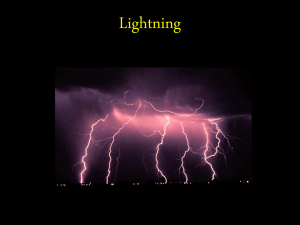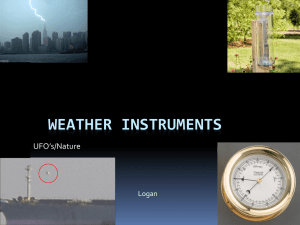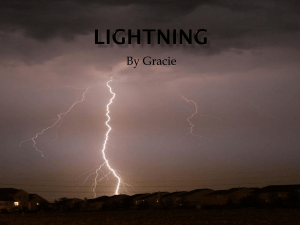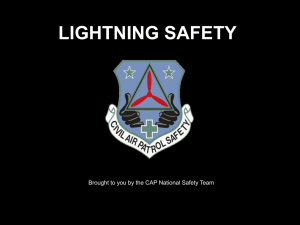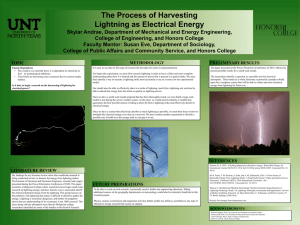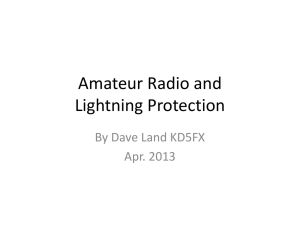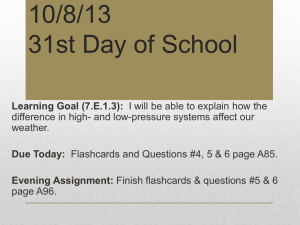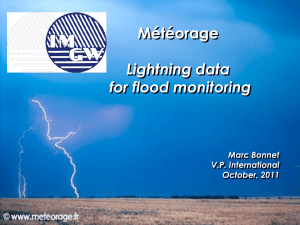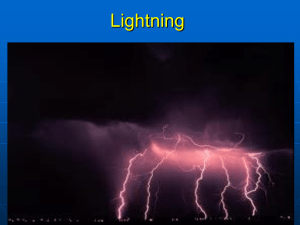GlobalLightningOccurrence
advertisement
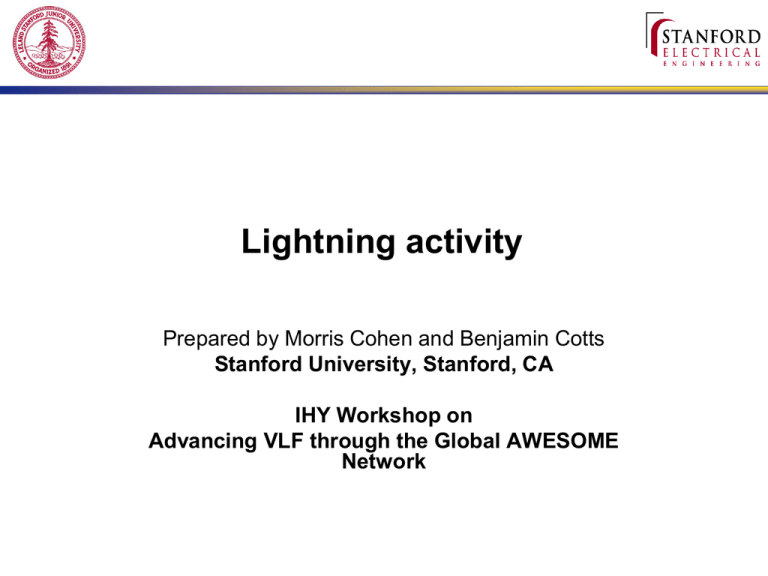
Lightning activity Prepared by Morris Cohen and Benjamin Cotts Stanford University, Stanford, CA IHY Workshop on Advancing VLF through the Global AWESOME Network Basic lightning physics + ++ + + + + + + ++ + + + + + + + - - - - - - - t=0 Charge builds up inside thundercloud, reaches breakdown threshold (~300 kV/m) 2 Basic lightning physics + ++ + + + + + + ++ + + + + + + + - - - - - - - t=1 ms Preliminary breakdown within cloud 3 Basic lightning physics + ++ + + + + + + ++ + + + + + + + - - - - - - v~200 m/ms t~1.1 ms Propagating “Stepped leader” forms ~30 s after electric field exceeds breakdown fields of air 4 Basic lightning physics + ++ + + + + + + ++ + + + + + + + - - - - - - I~1kA ~50m t~20 ms “Stepped leader” propagates down one “step” at a time, pauses (10s of s), might split into pieces 5 Basic lightning physics + ++ + + + + + + ++ + + + + + + + - - - - - - - + ++ + + + + + t~25 ms Ground electrified as stepped leader approaches 6 Basic lightning physics + ++ + + + + + + ++ + + + + + + + - - - - - - - + ++ + + + + + t~30 ms Ionized (~10,000 K) plasma streamers rise from ground (often from high points like treetops, poles, etc) to meet leader 7 Basic lightning physics + ++ + + + + + + ++ + + + + + + + - - - - - - - t~35 ms Leaders and some streamers connect Attachment process + ++ + + + + + 8 Basic lightning physics + ++ + + + + + + ++ + + + + + + + - - - - - - - I~10s of kA + ++ + + + + + t~35 ms Channel formed: high current flows at bottom of channel, beginning “return stroke” 9 Basic lightning physics + ++ + + + + + + ++ + + + + + + + - - - - - - v~0.4c + ++ + + + + + t~35 ms Return stroke propagates upward, comparable to speed of light 30,000 K temperatures 10 Basic lightning physics + ++ + + + + + + ++ + + + + + + + - - - - - - - + ++ + + + + + t~35 ms Return stroke reaches cloud Occurs much faster than stepped leader 11 Basic lightning physics + ++ + + + + ++ ++ + + + + + - - + + + + + t~36 ms Return stroke weakens as charge is depleted Total charge transfer typically in 1s of C 12 Basic lightning physics + ++ + + + + ++ ++ + + + + + - - t~90 ms Often several return strokes ~50 ms apart Typically weaker than first return stroke I~10 kA + + + + + 13 Basic lightning physics - + ++ + + + + ++ ++ + + + + - + - I~100 A t~200 ms Weaker “continuing currents” may continue for 100ms or more, transferring more charge. Sprites may be triggered at 10s of C transferred + + 14 Types of lightning + ++ + + + + ++ ++ + + + + + - IC - -CG + + +CG IC (Intracloud) Flash occurs within cloud Accounts for most of lightning activity -CG (Cloud-to-ground) Cloud lowers negative charge to ground More common CG type +CG Cloud lowers + charge Linked to most sprites Often only 1 return stroke + + + 15 Lightning Statistics In-Cloud (IC) 75% of total Cloud-to-Ground (CG) 25% IC may be intracloud, cloud-to-cloud, or cloudto-sky Of CG, >90% are -CG Typical CG currents 1–200 kA CG charge removal of 1–40 C (-CG), 20–350 C (+CG) Energy up to 10 GJ, power TW 16 Global occurrence rates ~ 2000 active thunderstorms 40-50 flashes per second Christian et al., 2003 17 Spatial variations Christian et al., 2003 18 Seasonal variations 19 Christian et al., 2003 Seasonal variations Movie HRAC_Globe.mov (need Quicktime) 20 United States Flash Rate 21 IC and CG ratios 22 Boccippio et al., 2001 Large +CG NLDN % + CG 23 NLDN +CG > 75 kA [10-3 fl/km2/yr] Boccippio et al., 2001 Available lightning data Satellites NASAs Lightning Imaging Sensor (LIS), Optical Transient Detector (OTD) http://thunder.msfc.nasa.gov/data/lisbrowse.html Data available from twice-per-day passes Ground networks METEORAGE – lightning over Europe Your AWESOME receiver 24 Broadband data and the “SPH” Channel 25

